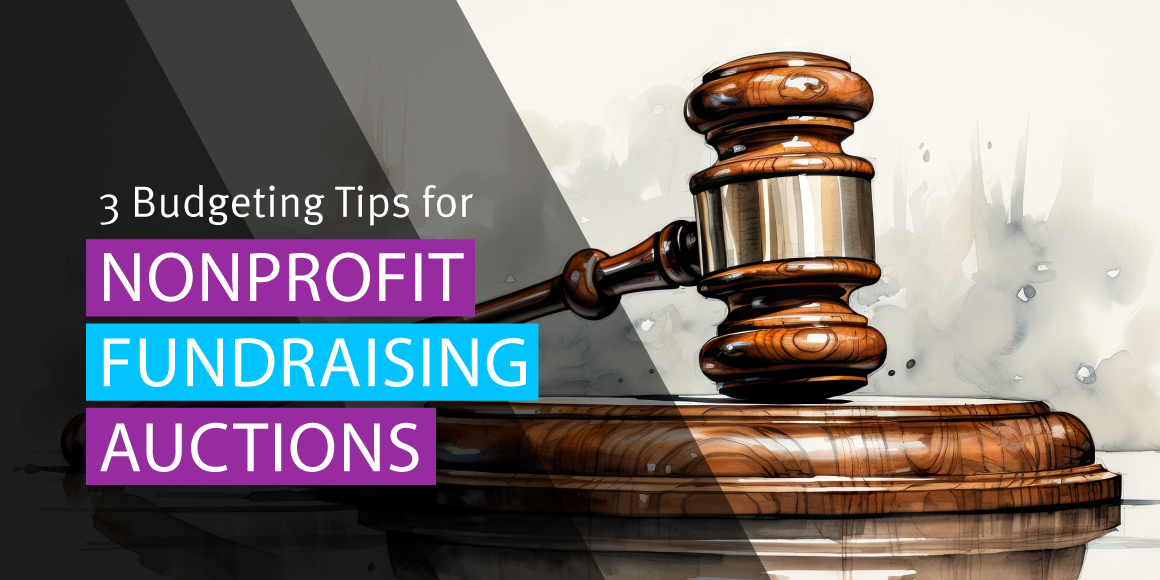Auctions are among the most engaging and lucrative fundraising events your nonprofit can host—and also the most complicated to organize. From finalizing event logistics to procuring prizes to creating a marketing plan, your team will have their hands full for several months leading up to the auction.
One of the most important (and often overlooked) aspects of planning a successful auction is budgeting. Having a clear budget that lays out all of your upfront spending will guide your employees’ and volunteers’ activities, minimize risk, and promote internal and external accountability from start to finish.
In this guide, we’ll discuss three tips to create a budget that will allow you to make the most of your nonprofit’s next fundraising auction. Let’s dive in!
1. Set Clear Budgetary Goals
Auction event budgets are just one of the many kinds of budgets your nonprofit may create. You’ll likely also have an annual operating budget that guides all of your spending and revenue generation for the year, as well as budgets for individual programs, grants, capital campaigns, and other highly involved fundraisers.
According to Jitasa’s nonprofit budgeting guide, all of these budgets should have three elements in common to be effective:
- Defined activities. Be as specific as you can about every aspect of your auction expenses and revenue to keep your team accountable. For example, instead of just lumping all marketing costs together, create subcategories under that heading for website updates, emails, social media posts, digital ads, flyers, mailed invitations, and any other promotional channels you plan to use.
- Specific time periods. While the focal point of your auction budget timeline will be your event day, you should also map out when you plan to incur certain costs during the planning process. Your budget will also likely extend past your event’s end as you bring in your last funds, follow up with participants, and potentially continue paying for event software subscriptions, depending on how you plan to use the tools and transfer data out of them.
- Realistic, measurable metrics. Review data from your nonprofit’s past fundraisers to determine what you’re capable of and set spending and fundraising goals from there. Your targets should be enough of a reach to push your team to maximize your event’s return on investment (ROI). However, don’t set fundraising goals so far out of reach that they’ll get discouraged or try to minimize costs to the point that you compromise the event’s quality.
NXUnite’s guide to starting a fundraiser recommends using the SMART method (Specific, Measurable, Attainable, Relevant, and Time-bound) to set budgetary and other event goals. This framework makes your goals more actionable and focused for your auction planning team.
2. Consider All Upfront Expenses
You’ve probably heard the saying “You have to spend money to make money,” and it rings true with auctions. While you should try to offset costs where possible, you’ll probably still need to spend a decent amount to make your event successful.
Some common auction expenses you’ll need to budget for include:
- Venue. While this only applies to in-person and hybrid auctions, it can be a significant cost if you don’t have an event space at your nonprofit’s facility. Make sure to rent a venue that’s accessible and large enough to safely accommodate all participants and event staff. Some venues may offer discounted rentals for charity events (especially other nonprofits like museums and aquariums), so do your research. Don’t forget to factor in other venue-related supplies like tables, decorations, and sound equipment as well!
- Refreshments. Most in-person and hybrid events feature at least some light snacks and beverages for participants, if not a full meal and bar service. In some cases, you might be able to get a catering company or restaurant to contribute refreshments as part of a sponsorship package, but in others, you’ll need to pay for them.
- Event software and fundraising materials. Even for in-person auctions, collecting registration forms and managing checkout is much easier if you have software to organize data and process payments. Plus, you’ll have to make a catalog for a live auction or bid sheets for a silent auction to guide the bidding. For hybrid and virtual events, you’ll need mobile bidding tools and livestreaming platforms to engage attendees.
- Marketing materials. As mentioned previously, a multi-channel marketing approach will help your auction reach more potential participants. Free and low-cost promotional tools like Canva or the Google Ad Grant can help offset communication expenses, but you may still need to spend more on some materials and design expertise.
- Auction items. While requesting in-kind donations from sponsors and individual supporters can help you procure smaller auction prizes such as certificates for services or the contents of gift baskets, big-ticket items like vacation packages and concert tickets will likely cost you. Take advantage of discounts and buy items on consignment when you can to reduce costs—not to zero, of course, but as much as possible.
Once you’ve offset as many costs as possible with in-kind gifts, sponsorships, and discounts, make sure to pay for the remaining expenses with your nonprofit’s unrestricted revenue (i.e., generally small to mid-sized contributions with no donor designations). Grantmakers and major donors often designate their contributions for specific projects and programs—not overhead like event expenses—and it’s important to follow through on those promises to retain their support.
3. Determine ROI From All Revenue Sources
Generally speaking, a successful fundraiser brings in more money than it costs, giving it a positive ROI. The higher the number, the better your auction’s payoff for your organization.
The tricky part of calculating ROI is taking into account all of the different ways your auction may bring in funding for your mission, such as:
- Ticket sales
- Auction item purchases
- Additional donations (donation boxes, text-to-give, etc.)
- Payments for food and beverages if you charge for them
- Sponsorships and other corporate philanthropy programs (e.g., volunteer grants for event volunteers)
- Revenue enhancers like raffles or merchandise sales
- Funds raised from other events paired with your auction, such as golf tournaments or 5K races
Projecting each of your auction’s funding streams separately will also help your event budget line up with your nonprofit’s records, which makes it easier to recognize and report revenue accurately. If you have questions about aligning these documents, calculating ROI, or any other aspect of auction budgeting, consult your nonprofit’s accountant.
After your nonprofit’s auction, look back at your budget and compare it to your actual event data to assess how well you followed it. Ask yourself questions like:
- Did the goals you set guide and motivate your team?
- Did you spend more or less than you expected to?
- Did you achieve the ROI you hoped for?
Evaluating these factors can help you create even more effective budgets for fundraising events and campaigns going forward so you can continue engaging donors and funding your mission.





live auctions
Choosing a budget for the event will require research and careful consideration. It depends on what kind of event you’re having. This is a helpful article on Budgeting Tips for Charity Auctions. You have done a great job with the article.